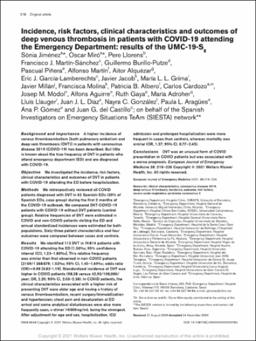Incidence, risk factors, clinical characteristics and outcomes of deep venous thrombosis in patients with COVID-19 attending the Emergency Department: results of the UMC-19-S8

View/
Date
2021-06Author
Cardozo, Carlos.
Jiménez, Sonia.
Miró, Oscar.
Et al.
Metadata
Show full item recordAbstract
Abstract
Background and importance: A higher incidence of venous thromboembolism [both pulmonary embolism and deep vein thrombosis (DVT)] in patients with coronavirus disease 2019 (COVID-19) has been described. But little is known about the true frequency of DVT in patients who attend emergency department (ED) and are diagnosed with COVID-19.
Objective: We investigated the incidence, risk factors, clinical characteristics and outcomes of DVT in patients with COVID-19 attending the ED before hospitalization.
Methods: We retrospectively reviewed all COVID patients diagnosed with DVT in 62 Spanish EDs (20% of Spanish EDs, case group) during the first 2 months of the COVID-19 outbreak. We compared DVT-COVID-19 patients with COVID-19 without DVT patients (control group). Relative frequencies of DVT were estimated in COVID and non-COVID patients visiting the ED and annual standardized incidences were estimated for both populations. Sixty-three patient characteristics and four outcomes were compared between cases and controls.
Results: We identified 112 DVT in 74 814 patients with COVID-19 attending the ED [1.50‰; 95% confidence interval (CI), 1.23-1.80‰]. This relative frequency was similar than that observed in non-COVID patients [2109/1 388 879; 1.52‰; 95% CI, 1.45-1.69‰; odds ratio (OR) = 0.98 [0.82-1.19]. Standardized incidence of DVT was higher in COVID patients (98,38 versus 42,93/100,000/year; OR, 2.20; 95% CI, 2.03-2.38). In COVID patients, the clinical characteristics associated with a higher risk of presenting DVT were older age and having a history of venous thromboembolism, recent surgery/immobilization and hypertension; chest pain and desaturation at ED arrival and some analytical disturbances were also more frequently seen, d-dimer >5000 ng/mL being the strongest. After adjustment for age and sex, hospitalization, ICU admission and prolonged hospitalization were more frequent in cases than controls, whereas mortality was similar (OR, 1.37; 95% CI, 0.77-2.45).
Conclusions: DVT was an unusual form of COVID presentation in COVID patients but was associated with a worse prognosis.
Collections
The following license files are associated with this item:

